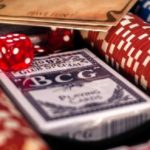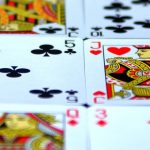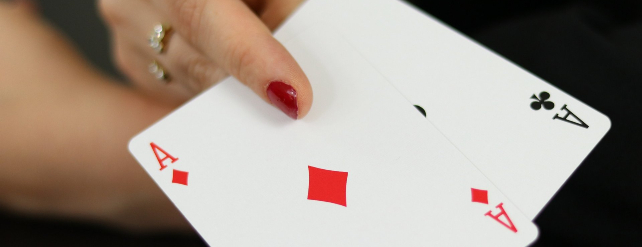
Single Deck Blackjack Strategy: Optimal Plays, Basic Strategy Charts, etc.
Blackjack games are among the most popular activities when it comes to (online) gambling. Each one of us will at least know about the crucial number 21, even though not everyone will be familiar with the actual Blackjack game rules. Casino games like Blackjack are not unified likewise and can show their face in all forms and variations. Actually, nowadays playing Blackjack is quite different from what it used to be in the past. One of those major changes is the ongoing disappearance of single-deck Blackjack games.
Easy enough to grasp that a single-deck Blackjack game is played with just one deck. Meaning that fewer cards overall are part of the shoe (if there is a shoe even). To be more precise, single-deck Blackjack contains 52 cards all in all. A single-deck game just like any other Blackjack game includes 2s to 10s with their respective value, face cards (Jacks, Queens, and Kings) which are also worth 10 as well as Aces which can either show a value of 1 or 11. Let us, first of all, find out why single-deck Blackjack games are not common anymore!
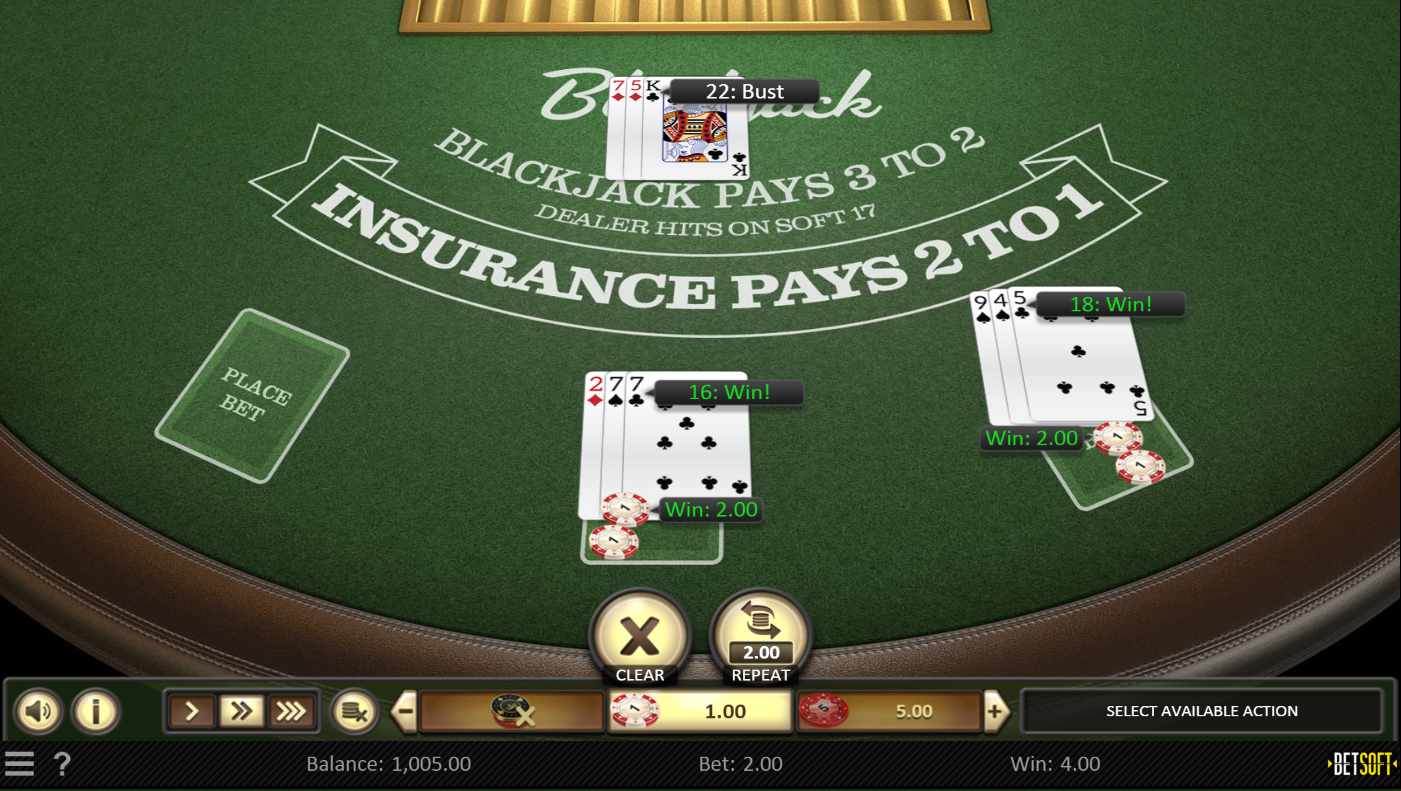
The Demise of Single-Deck Games
As every experienced Blackjack player will know, single-deck Blackjack used to be the big thing back in the day. Their clear advantage was that they offered a very low house edge which could go down to just 0.15%. This of course sparked the interest of Blackjack players using optimal strategy. Also playing single-deck Blackjack made it easy and convenient for card counters to have a running count and turn the tides towards player advantage.
Card counting is basically the act of attaching a value of each and every card within the deck starting with the dealt hand. Values can be either +1, 0, or +1. Counting cards is accordingly played upon the statistical evidence that high-value cards (every picture card, aces, 10s, and 9s) are more beneficial for the player.
Contrarily, lower-valued cards such as 2s to 7s are considered helpful for the Blackjack dealer. You can read more about this Blackjack strategy of card counting in our following article around the subject of how to count cards, and more.
Casinos were aware of this though and went on to change the structure of decks. The lowest house edge was now replaced by double-deck and furthermore multi-deck Blackjack games. This was happening in order to both prevent card counting to be as non-complicated as before and also to increase the house edge once more.
This also occurred in online casinos which either way shuffled the deck before every new hand. A running count was made hard to follow up on in any case under those circumstances.
More Decks counteract the Lowest House Edges
Instead of single-deck Blackjack, many casinos all over the world started to commonly capitalize on six to eight decks. Multiple decks complicate matters for sure.
Not only do the remaining cards increase with each additional deck but multiple-deck Blackjack also fosters the house edge. Additionally, the payouts in single-deck Blackjack were usually 6:5. Meanwhile, multi-deck Blackjack cuts this down to 3:2.
Online Blackjack even stirs up the ingredient of automated shuffling after each hand. Both the computerized version and also live dealer Blackjack use up to eight decks.
Any type of Blackjack strategy becomes harder and harder with those multi-deck games. Only one deck was a delight for pretty much every type of Blackjack player but a multi-deck game needs more investment in each sense.
Single-Deck Blackjack House Edge
As we already mentioned beforehand, single-deck Blackjack offers a house edge of only 0.15%. This circumstance aligns with the casino rules nonetheless. Since this is not just a matter of how many decks are actually played at this specific moment. The specific rules which have an influence on the house edge are:
- Dealer hits on soft 17 vs. dealer stands on soft 17 (the latter reduces the house edge)
- Pair splitting is only allowed once vs. re-split
- Double down rules: You can double down after a split vs. you cannot (the latter increases the house edge)
- You are allowed to surrender vs. you are not allowed to surrender
- Payouts of Blackjack variations
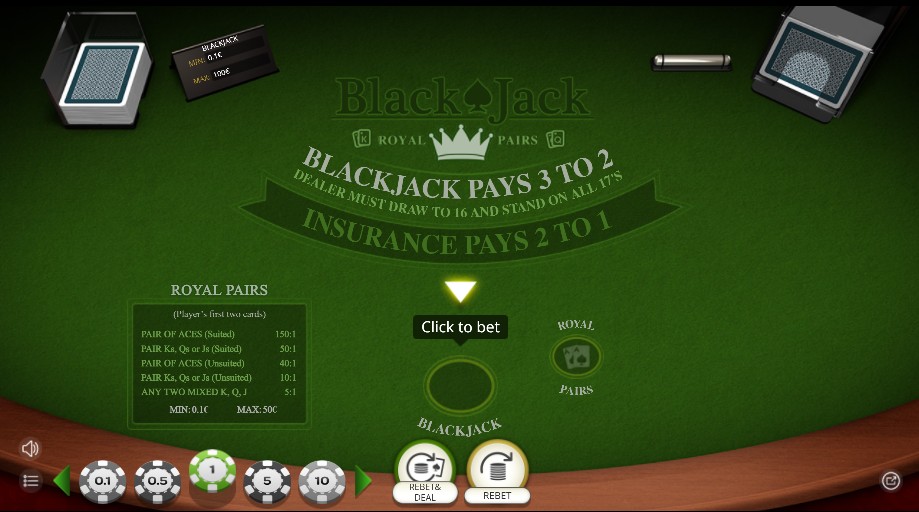
No-Gos of Single Deck Blackjack Strategy
There are certain actions in a single-deck Blackjack game that you should never go for. Give attentive care for those single-deck Blackjack tips and you are well equipped to not make those capital mistakes:
- Do not waste your money on an insurance bet while you play Blackjack. The same goes for even money. The low house edge of single-deck Blackjack can easily increase by an increment of 5,90% when doing so.
- Do not forget to use a Blackjack chart to memorize a basic strategy. Without it, you will not see the light of day.
- Do not split 10s since it is pretty clear that you will not get a better hand value than 20.
- Do not exaggerate your bankroll capacities. Play responsibly and head for stakes suiting your bankroll in order to stay in the game.
The Best Single-Deck Blackjack Strategy
Given the case that you managed to find a single-deck Blackjack game (which is hard enough nowadays), you will face different starting points. The central one is the question of whether the dealer hits on soft 17 or if the dealer stands on soft 17. It all depends on the house rules and in this context, we will dig deeper and have the dealer hit.
Furthermore doubling down after splitting is oftentimes ruled out just as well as surrendering. Thereby increasing the house edge. Let us have a closer look at basic strategy whenever the dealer hits on soft 17 in our case.
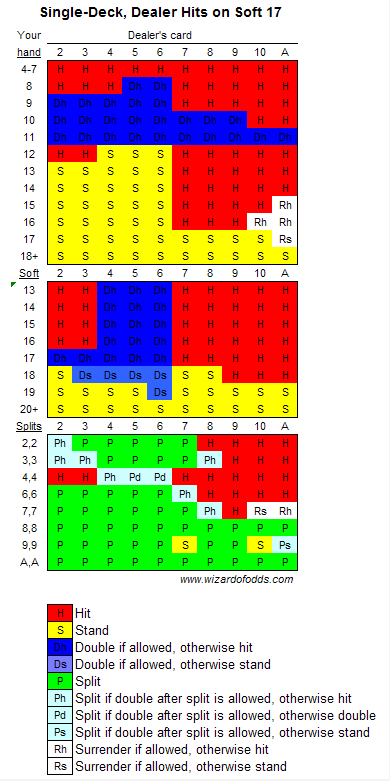
In order to read the Blackjack strategy chart, you analyze the vertical line as your own first two dealt cards. The horizontal line on the other hand is the dealer’s up-card.
The single-deck Blackjack chart also both deals with hard totals (no Ace is established within the first two cards) and soft totals (an Ace with the value 11 is included in the player’s hand).
Additionally, you will discover suggestions on when to split or hit if you have two of the same cards in your hand.
Keep in mind that 10s are left out of the equation since it is not always aligned whether you can split ten-valued cards in general or only ten-valued cards of the same rank. Like for example a pair of Jacks but not a Queen and a Jack.
How to win at Single-Deck Blackjack: Step by Step
Hard Totals (specific single-deck Blackjack rules apply)
- if your first two cards show a value of 4-7 you should always hit
- if it is 8 you should mostly hit. If the dealer’s upcard is 5-6 you should double down if possible, otherwise hit.
- on a hard total of 9, you should double down vs. dealer’s up-card 2-6. If this is not possible, then you should hit. Other than that hitting is the preferable option.
- on a hard 10, you should double down vs. dealer’s upcard 2-9. If not applicable, always hit also in cases beyond this.
- on a hard 11, you should double down on all upcards or hit if not eligible for you.
- on a hard 12, you should stand on the dealer’s upcard 4-6 and hit in any other case.
- on a hard 13, you should stand on the dealer’s up-card 2-6 and otherwise hit.
- the same as for a hard total of 13 goes for hard totals 14, 15, and 16. Surrendering is not included in our model.
- on hard totals of 17 and 18+, you should definitely stand in any case.
Soft Hands
- on soft totals 13 to 16: if the dealer shows an upcard 4-6 double down if possible, otherwise hit. In any other case, hit.
- on a soft total of 17, you should double down if the dealer shows an upcard 2-6. If this is not allowed you should hit. Beyond that upcard range, you should hit.
- if the dealer shows an up-card 9 to Ace in case you have a soft 18, you should hit. On 3-6, you should double down if you are allowed to, otherwise stand. If the dealer shows 2, 7, or 8 you should stand with your soft 18.
- on soft hands 19 and 20+, you should pretty much uniformly stand.
Basic Strategy of Splitting
- Always split Ace and Ace. If you stand Ace, Ace you either have a value of 2 or soft 12. Both hands are problematic.
- Always split Eights.
- Split 9s if the dealer shows an upcard 2-6, 8-9, or Ace. On 7 and/or 10 you stand.
- Split 7s if the dealer shows 2-7, otherwise hit.
- Split 6s if the dealer shows 2-6, otherwise hit.
- Do not split 4s but hit and double (if possible) whenever the dealer shows an upcard 4 to 6.
- Splits 3s if the dealer shows 4-7 and otherwise hit.
- Split 2s if the dealer shows an up-card 3-7 and otherwise hit.
Just a Single Deck makes Card Counting easy
Single-deck Blackjack only consists of 52 cards which makes it very easy to count cards. Thereby reverting an either way low house edge and gaining your own edge of up to 3% in the process. Please pay attention to the fact that this is tackling a single-deck game in brick-and-mortar casinos. Online Blackjack does not allow for card counting.
So whenever you play Blackjack casino games with one deck you can simply do the following (Hi-Lo system):
- in case a 2-6 card is dealt, just calculate by the increment +1 towards the running count.
- in case 2-9 is dealt, handle it as ambivalent and leave the count untouched.
- in case 10s or Ace is dealt, subtract -1 from the count.
If the running count is in the positive zone, you can scale your size of bets accordingly. The higher the count, the more sizable the bet can be. A one-deck game is the easiest you could ever use card counting on. This is why multi-deck games came into play as we already emphasized.

Concluding Remarks
A single-deck Blackjack strategy that we have laid out here does not demand a lot of memorizing potential. The basic strategy covers all the necessary actions which need to be taken in whatever context among the originally dealt cards from one deck only. Our strategy charts will be very helpful here for you in order to grasp the full potential in casinos.
The issue at hand is that casinos have slowly diminished single-deck Blackjack (strategy) by going over to multi-deck Blackjack games. The more decks, the higher the house edge and the more complicated formerly basic strategy becomes.
Counting cards is simple and self-explanatory in a casino offering single-deck Blackjack. With double-deck and higher, the complexity scales. And in online casinos with their ongoing shuffling of cards, it is pretty much made impossible.
Single-deck Blackjack might nowadays be more of an oddity than anything else. Nevertheless, those single-deck games still exist. Have a look at our completely free list of table games to discover quite a decent amount of amazing single-deck Blackjack variations.
And if you get lucky enough to stumble upon a 3:2 single-deck game in a casino: use our strategy and make the best out of your chances!
Single-Deck Blackjack Strategy FAQ
Is it better to play single-deck Blackjack?
Generally, yes. Since a single-deck game only inhabits 52 cards within the shoe, it is very easy to keep track of the cards. The house edge with single-deck games drastically decreases and by using card counting, you can simply turn the advantage onto your ends. Actually, it is more of an issue to find those variations of Blackjack in a casino than anything else.
What are the odds of winning in single-deck Blackjack?
Given the aspect, that you are capitalizing on basic strategy while playing Blackjack, you can reduce the house edge down to merely more than 0,15%. The house edge scales with the number of decks and also the house rules typically. Further reducing (and reverting) the house edge and thereby boosting the odds is only possible via card counting nonetheless.
What is the best single-deck Blackjack strategy?
Just read our article and you will detect the most suitable Blackjack strategy for your own needs. Combine optimal play (when to split, when to double down, never use an insurance bet since it increases the house edge by 5,9%, etc.) with counting cards and you will arrive at the desired rocket-launch position.
Do Blackjack dealers use one deck?
Players in a casino definitely faced dealers with only one deck in the past. Just like it would be played at home among friends and colleagues. With the influx of card counters, casinos switched over to double-deck, six decks, eight decks, or even more in the shoe. Whereas a single-deck Blackjack strategy is self-explanatory, this results in more heavily loaded (perfect) strategies. While it also challenges card counters a lot. You can still find one-deck games in smaller casino venues and online casinos. In the online context, constant shuffling of cards is hardening your gambling life though.
